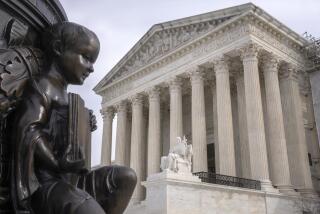RELIGION : New Ruling on Displays of Religious Scenes Is Asked
- Share via
WASHINGTON — It’s Christmas. And that means creche and that, in turn, means court.
On Wednesday, five major religious groups announced that they have asked the Supreme Court to reconsider its 1983 decision that permits government promotion of Christian Nativity scenes under certain conditions.
In a friend-of-the-court brief, the five groups said the 1983 decision, Lynch vs. Donnelly, “is fraught with difficulties” and should be set aside.
The brief was filed in connection with a new case the court has agreed to hear involving a creche that had been placed on the main staircase of the Allegheny County Courthouse and a menorah that was put on the front steps of the Pittsburgh City-County Building.
Both displays have been barred as a a result of a federal appeals court decision.
“A creche, which depicts the birth of Jesus as the birth of divinity, is unmistakably and unalterably religious, indeed doctrinal in nature,” the brief said. “Similarly, a menorah is a religious symbol, ceremonially used to fulfill a religious obligation.”
It also argues that both displays had been exhibited in buildings “devoted to core functions of government,” thereby suggesting governmental endorsement of their religious messages.
“The constitutional principle of separation of religion and government means that government should not become involved with religions unless there is a religious need that cannot otherwise be met--for example, military chaplains for the armed forces,” said Samuel Rabinove, legal director of the American Jewish Committee, one of the groups filing the brief.
“There is no religious need to place sacred symbols of any faith in government buildings,” he said. “There are many private spaces readily available for the public display of sacred symbols such as the creche and the menorah--for example, churches, synagogues, religious schools, private homes, lawns and storefronts.”
In the brief, the National Council of Churches, one of the other filing groups, said it objected to a creche in a government building because it “not only secularizes and degrades a sacred symbol of Christianity but also represents a rather presumptuous identification by government with that religion and its symbols, or an equally presumptuous identification by Christians of their religious traditions with the institutions of government.”
In the 1983 Lynch case, the Supreme Court ruled 5-4 that a Nativity scene displayed by the municipal government on private property was constitutional. It based its decision in part on the fact that secular symbols of Christmas surrounded the creche, muting its religious effect.
In the new case, however, the religious symbols stood alone.
Robert Maddox, executive director of Americans United for Separation of Church and State, which joined the American Jewish Committee and the National Council of Churches, said a decision in favor of the government-sponsored creche and menorah “will be used to encourage other types of church-state entanglement.”
“Ultimately,” he said, “it may threaten our nation’s long-standing principle of church-state separation.”
“Government is simply not the proper agent to convey religious messages,” he said. “In a pluralistic nation where people hold a variety of beliefs, it is important that the state remain neutral in religious matters.”
Also joining in the brief were the Union of American Hebrew Congregations and the Council on Religious Freedom.
More to Read
Sign up for Essential California
The most important California stories and recommendations in your inbox every morning.
You may occasionally receive promotional content from the Los Angeles Times.










